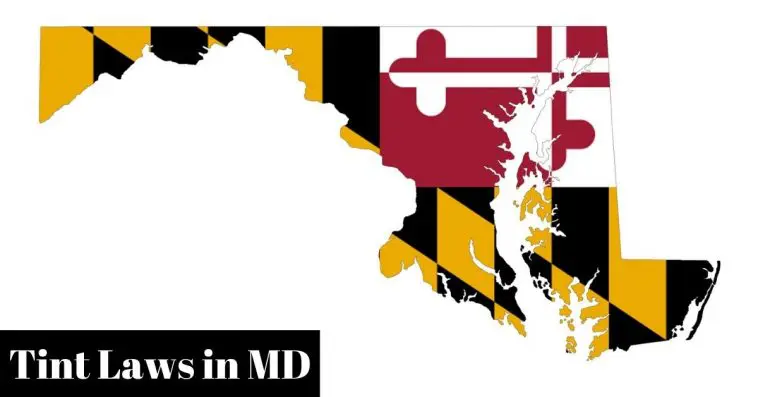Like all other states, the state of Maryland has its own legal standards for car window tints that it enforces.
If you’re considering adding window tint to your car, it’s imperative that you have an understanding of what is legal and what isn’t before you do so, as it can potentially save you a lot of money and legal issues down the road.
In this article, we’ll be taking a look at the various regulations that the state of Maryland has in place regarding window tint for your car.
We’ll also go over the process for getting a medical exemption for people who have legitimate reasons for tinting their windows beyond what is normally legal.
TABLE OF CONTENTS
Are You Allowed To Have A Tinted Windshield And Windows In Maryland?
You can indeed have a tinted windshield and windows installed on your car if you are a resident of Maryland.
Of course, there are restrictions in place as to what kind of window tint you can install on your vehicle.
Additionally, the restrictions are different depending on what type of vehicle you have. We’ll go into more detail about these different restrictions later in this article.
What Is The Darkest Tint You Can Legally Get In MD?
This depends on what specific windows you want to tint and what type of vehicle you own.
For passenger vehicles like sedans and coupes, none of your windows can be tinted lower than 35% VLT.
VLT means “Visible Light Transmission,” and it is used as a measurement of how much light can pass through a car window. A VLT of 35% means that the window cannot block any less than 35% of all visible light.
MPVs, on the other hand, have no tint restrictions for the backside windows and rear windows. However, the laws pertaining to window tints for front side windows and windshields remain the same.
Additionally, windshields can’t be completely tinted; they may only have a strip of non-reflective 35% VLT tint at the very top. This strip can’t be wider than 5,” and it also can’t extend past the AS-1 line on the windshield.
Is 20% Tint Illegal In MD?
It depends on what kind of vehicle you have and which windows you’re tinting.
If your vehicle is an MPV and you want to tint the back side windows and rear window, there are no restrictions on how dark your tint can be, and you can install tint with a VLT of 20% or less if you want.
For other vehicle types and other windows, you’ll have to seek out a medical exemption if you want to tint your windows darker than what is legal.
Can You Get Pulled Over For Tinted Windows In Maryland?
If you’ve tinted your windows too dark and you don’t have a medical exemption for it, you can definitely be ticketed for this.
You’ll also likely be issued a Safety Equipment Repair Order (SERO); this will require you to remove your illegal window tint within a certain amount of time.
Once you complete the required repairs, you’ll also have to send a certification proving you completed them to the Maryland state police.
How Much Is A Tint Ticket In MD?
A ticket for illegally-tinted windows is $50; however, if you’ve been issued such a ticket and you fail to go to a certified inspection station to prove that you fixed the problem, you may be issued a fine of up to $1000.
Window Tint Darkness In Maryland
While most states share the same restrictions for passenger vehicles and MPVs, Maryland is one of the few states with different rules in place depending on what kind of vehicle you own.
Passenger vehicles are defined as “standard” vehicles like sedans, hatchbacks, station wagons, and coupes. These vehicles are designed primarily for personal transportation.
MPVs (multi-purpose vehicles) are usually designed for utility rather than simply for commuting. MPVs include SUVs, pickup trucks, cargo vans, RVs, and minivans.
In this section, I’ll summarize the different restrictions in place for both types of vehicles.
For Passenger Vehicles
- Windshields can only have a line of non-reflective 35% VLT tint; this line can’t be wider than 5″ and can’t go below the windshield’s AS-1 line
- Front side windows can’t be tinted darker than a 35% VLT
- Backside windows can’t be tinted darker than a 35% VLT
- Rear windows can’t be tinted darker than a 35% VLT
For MPVs
- Windshields can only have a line of non-reflective 35% VLT tint; this line can’t be wider than 5″ and can’t go below the windshield’s AS-1 line
- Front side windows can’t be tinted darker than a 35% VLT
- Backside windows can be tinted to any level of darkness
- Rear windows can be tinted to any level of darkness
Window Tint Reflection In Maryland
Most states have laws that limit how reflective window tints can be and how much light they can let through.
The state of Maryland doesn’t have specific restrictions for the amount of light your windows can reflect; however, it does state that windows can’t have a mirrored or metallic appearance in general.
Some colored tints may be used, although the colors yellow, red, and amber are illegal to have on any vehicle.
For Passenger Vehicles
- Front side windows can’t have a mirrored or metallic appearance
- Backside windows can’t have a mirrored or metallic appearance
For MPVs
- Front side windows can’t have a mirrored or metallic appearance
- Backside windows can’t have a mirrored or metallic appearance
How Do You Get A Medical Exemption For Window Tint In Maryland?
If you have a medical condition in which exposure to sunlight can negatively impact your health, you may be eligible for a medical exemption for your window tint.
To get a medical exemption, you’ll have to get a written certification from a doctor stating that you do, in fact, have a medical condition that requires heavily tinted windows for your vehicle.
Once you have this certification, you’ll have to submit it along with a medical exemption application form to the Maryland DMV.
You may only get a medical exemption for your side windows and rear window; windshields can’t be altered beyond standard regulations in any way.
Conclusion
No matter what state you live in, it’s important to be aware of your state’s laws regarding window tint. Driving around with illegally-tinted windows can land you in a bunch of legal trouble, which is obviously never desirable.
If you’re in need of any other information concerning Maryland’s vehicle laws, you can find all sorts of additional info on the Maryland DMV website.




